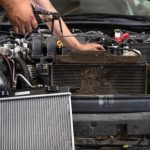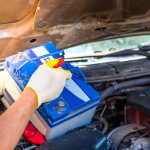Have you ever been driving down the road when your engine suddenly begins to sputter, leaving you feeling anxious and frustrated? You’re not alone! Engine sputtering is a common issue that many drivers encounter at some point in their automotive journeys. Understanding the reasons behind this unsettling phenomenon is the first step toward restoring your vehicle’s performance.
In this article, we will explore the top reasons your engine might be sputtering, along with practical solutions to help you get back on the road smoothly. Whether you’re a seasoned car enthusiast or a casual driver, our friendly guide will equip you with the knowledge you need to tackle this pesky problem head-on. Let’s dive in and uncover the mysteries of engine sputtering!
Table of Contents
- Understanding Engine Sputtering: Common Causes to Consider
- Identifying Signs of a Sputtering Engine: What to Look For
- Practical Solutions to Fix Engine Sputtering Issues
- When to Seek Professional Help for Engine Troubleshooting
- Q&A
- Concluding Remarks

Understanding Engine Sputtering: Common Causes to Consider
Engine sputtering can be a frustrating issue for any driver, often signaling that something isn’t quite right under the hood. One common cause is a fuel delivery problem, which can stem from a clogged fuel filter or a failing fuel pump. When the engine doesn’t receive a consistent fuel supply, it can cause sputtering or hesitation during acceleration. Another potential culprit is a malfunctioning spark plug or ignition coil. These components play a crucial role in igniting the air-fuel mixture; if they’re worn or damaged, the engine may misfire, leading to irregular performance.
Environmental factors can also contribute to engine sputtering. For example, contaminated fuel can introduce dirt and debris into the combustion chamber, disrupting the smooth operation of the engine. Additionally, issues with the mass airflow sensor or oxygen sensor can throw the air-fuel mixture out of balance, resulting in sputtering. Regular maintenance and timely inspections are key to identifying these issues before they escalate. Here’s a quick overview of potential causes:
| Cause | Description |
|---|---|
| Fuel Delivery Issues | Clogged filters or failing pumps disrupt fuel flow. |
| Spark Plug/Ignition Coil Failure | Worn components can lead to engine misfires. |
| Contaminated Fuel | Impurities in fuel can cause uneven combustion. |
| Sensor Malfunctions | Faulty sensors disrupt air-fuel mixture balance. |
Identifying Signs of a Sputtering Engine: What to Look For
Detecting a sputtering engine can often feel like deciphering a cryptic message from your vehicle, but there are clear signs to pay attention to. One of the most notable indicators is a rough idle – if your car shakes or vibrates when at a standstill, it’s a strong signal that something’s amiss. Additionally, listening for a misfiring sound can help you pinpoint the issue; often, a sputtering engine will emit irregular sounds that differ from its usual hum. You may also notice a decrease in acceleration performance, where your vehicle hesitates or struggles to gain speed when you press the gas pedal.
Other visual and operational cues can provide further insight into the sputtering issue. Watch out for check engine lights that illuminate unexpectedly, as they can indicate various engine problems. Furthermore, an increase in fuel consumption or a lingering smell of gasoline may suggest that your engine is not firing correctly. Don’t forget to check under the hood; if you spot any signs of leaking fluids or damaged components, these could contribute to the sputtering as well. Keeping an eye on these signs can help you address engine issues before they escalate.
Practical Solutions to Fix Engine Sputtering Issues
Addressing engine sputtering requires a thorough approach to identify and remedy the underlying causes. Start with the simplest solutions by checking your fuel supply. Make sure you have enough fuel in the tank; running low can cause spluttering as your fuel pump struggles to maintain adequate pressure. Next, inspect the fuel filter—a clogged filter can restrict fuel flow, leading to sputtering. If your fuel system checks out, consider evaluating the spark plugs and ignition system. Worn or dirty spark plugs can misfire, causing inconsistent engine performance. Replace these components if they appear damaged or excessively worn.
Another critical area to investigate is the air intake system. A dirty or obstructed air filter can limit airflow, leading to a rich fuel mixture that causes sputtering. If cleaning or replacing the air filter doesn’t resolve the issue, the mass air flow sensor (MAF) may need cleaning, as a malfunction can disrupt the air-fuel mixture. Additionally, examine the vacuum hoses for leaks; even small cracks can lead to a lean mixture, resulting in engine performance issues. Here’s a quick reference table summarizing these potential solutions:
| Component | Possible Solution |
|---|---|
| Fuel Supply | Check fuel level and replace filter if clogged |
| Spark Plugs | Inspect and replace worn or dirty plugs |
| Air Filter | Clean or replace if dirty |
| Mass Air Flow Sensor | Clean sensor if malfunctioning |
| Vacuum Hoses | Inspect for leaks and replace damaged hoses |
When to Seek Professional Help for Engine Troubleshooting
While many engine issues can be resolved with some basic troubleshooting and DIY solutions, there are instances when your vehicle may require the expertise of a professional. If you experience continuous sputtering after attempting common fixes, or if the problem is accompanied by unusual noises, persistent warning lights, or drastic changes in performance, it’s a clear indication that you should seek help. Other signs include:
Frequent stalling that doesn’t improve with gas pedal adjustments.
Increased fuel consumption that isn’t linked to your driving habits.
Engine overheating or other cooling system issues that arise suddenly.
Professional mechanics possess the advanced tools and diagnostic equipment that go beyond simple visual inspections. They can perform in-depth analyses that pinpoint the precise issue affecting your engine. Moreover, if you notice fault codes generated by the engine control unit (ECU) that remain unresolved, it’s time to consult a technician. Recognizing the right moment to consult a specialist can save you both time and money in the long run. Some additional indicators that warrant professional attention include:
| Indicator | Action |
|---|---|
| Check Engine Light | Get a diagnostic scan |
| Excessive Smoke | Visit a mechanic immediately |
| Unusual Vibrations | Schedule an inspection |
Q&A
Q1: What does it mean when my engine is sputtering?
A1: Engine sputtering is a term used to describe a rough or uneven operation where the engine hesitates, loses power, or shakes. It often indicates a problem within the engine or fuel system that needs attention.
Q2: What are the most common causes of engine sputtering?
A2: There are several potential causes for engine sputtering, including:
- Fuel Issues: Contaminated or low-quality fuel can disrupt the combustion process.
- Ignition System Problems: Faulty spark plugs, ignition coils, or wires can lead to misfires.
- Air Intake Problems: Dirty air filters or issues with the mass air flow sensor can restrict airflow, affecting performance.
- Fuel System Issues: Clogged fuel injectors or a failing fuel pump can impede fuel delivery.
- Vacuum Leaks: Any leaks in the vacuum system can lead to an imbalanced air-fuel mixture.
Q3: How can I diagnose the issue myself?
A3: You can perform a few basic checks:
- Listen for Sounds: A sputtering engine may produce unusual noises or vibrations.
- Check Dash Lights: Pay attention to any warning lights on your dashboard.
- Inspect Spark Plugs: Remove and examine spark plugs for wear or fouling.
- Observe Fuel Quality: If you suspect bad fuel, consider draining the tank and refilling it with high-quality gasoline.
- Look for Leaks: Inspect hoses and connections for visible signs of wear or leaks.
Q4: When should I seek professional help?
A4: If basic troubleshooting doesn’t resolve the issue, or if you notice additional symptoms like overheating, decreased fuel efficiency, or persistent warning lights, it’s best to consult a professional mechanic. They have the tools and experience to diagnose complex problems accurately.
Q5: What are some quick fixes I can try to resolve sputtering?
A5: Here are a few quick solutions to try:
- Change or Clean Spark Plugs: If they’re worn out or dirty, replacing them can improve performance.
- Replace the Air Filter: A clean air filter can enhance airflow and engine efficiency.
- Use Fuel Additives: Fuel system cleaners can help dissolve deposits in fuel injectors.
- Check Fuel Pressure: If you have a gauge, ensuring the fuel pump is delivering adequate pressure could resolve fuel delivery issues.
Q6: Can regular maintenance prevent engine sputtering?
A6: Absolutely! Regular maintenance, such as oil changes, air filter replacements, and timely inspections of the fuel and ignition systems, can help prevent potential issues from developing. Keeping your vehicle well-maintained ensures optimal performance and longevity.
Q7: What if my engine sputters intermittently?
A7: Intermittent sputtering may signify an issue that only manifests under specific conditions (like accelerating or idling). This could indicate a problem with electronic sensors or intermittent fuel delivery. Continuous monitoring of the symptoms can provide valuable information for your mechanic.
Q8: Are there any long-term effects of ignoring a sputtering engine?
A8: Yes, neglecting a sputtering engine can lead to more severe damage over time, including issues with the catalytic converter, increased emissions, and ultimately, engine failure. Addressing the issue early helps save time and money on more extensive repairs later.
By understanding the reasons behind engine sputtering and taking proactive steps to address them, you can keep your vehicle running smoothly and enjoy a safer driving experience. Happy driving!
Concluding Remarks
experiencing a sputtering engine can be both frustrating and concerning, but understanding the potential causes can empower you to address the issue with confidence. From fuel system problems to ignition system failures and everything in between, the key is recognizing the symptoms early and seeking the right solutions. Whether you decide to tackle the repairs yourself or consult a professional mechanic, staying informed will help ensure your vehicle runs smoothly and efficiently. Remember, regular maintenance is your best defense against future sputtering and other engine issues. So, the next time you find yourself asking, “Why is my engine sputtering?” you’ll have the knowledge to diagnose and tackle the problem head-on. Safe travels, and happy driving!











